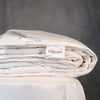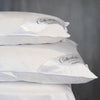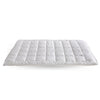6 pitfalls when buying duvets & pillows
When buying duvets and pillows, there are also various pitfalls that you can avoid. We show you what they are and how to recognize them.
100% down or not?
When talking about a "high-quality down comforter", the trained eye quickly recognizes that there is no information there. Exactly what percentage of high-quality down is it? If there is no information, often only about 50-80% pure down is used and the rest is simply filled with feathers. This is often the case, especially with cheaper providers.
In the belief that you have bought a very high-quality blanket, you will be sitting up straight in bed during the rehearsal nights at the latest - if the rehearsal nights are offered at all.
Therefore, always pay attention to the percentage in the description. And if it's not there: Ask support how high the percentage of down is in the duvet.
It is perfectly fine for a pillow to use springs for better stability.
The weight of down/feathers per square meter
Also a little thing that the experienced buyer of duvets and pillows pays attention to: How many grams of down per square meter are used in the duvet? The density of the down is largely responsible for how warm it gets under your duvet. A year-round duvet should not be less than 200 grams of down per square meter so that it doesn't get too cold in winter.
New vs. old down/feathers
A small but subtle difference that very few are aware of when buying duvets is whether the down/feathers are new or old or used. Some manufacturers in the lower price segment go and mix in the new springs with used ones in order to meet the required weight. This is comparable to a toothbrush. As a rule, an older toothbrush still works, but not as well as a new one. In addition, for reasons of hygiene, it is better not to use used down/feathers.
Down is not just down – duck vs. goose
Even if the product description speaks of high-quality down, that does not mean that the down is really that high-quality. There is a qualitative difference between down and feathers from ducks or geese. Goose down is usually stronger and larger than duck down and is therefore more stable. The reason for this is relatively simple: geese are larger and have a longer lifespan.
So if you want the better product, make sure the description says goose down and not duck down or just down. Cottonbabe only uses high-quality white goose down.
Sustainability & Ethics
Low-cost providers in particular do not look too closely at the topic of sustainability and ethics. The origin of the feathers and feathers is not always clear and there is little transparency across the entire supply chain.
Therefore, unless explicitly excluded in the product description, the feathers and down may be plucked from live animals. At Cottonbabe you can be sure that we 100% do not allow live plucking of our down and feathers.
No rehearsal nights
If we at Cottonbabe weren't 100% convinced of the quality of our product, then we probably wouldn't be offering you 30 rehearsal nights.
Our insight from this is that many providers are probably not as convinced of their own product as they make it out to be in their marketing descriptions.
Because often an exchange or return of blankets and pillows is generally refused or only allowed if the product has not yet been used. As a rule, this is of little use to the customer, since it means that he cannot test the product.
So if you don't want to spend too much money, always make sure that you can test sleep for at least 14 days and that you can always return the duvet if you don't like it.















Leave a comment